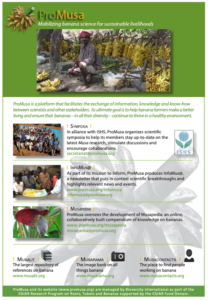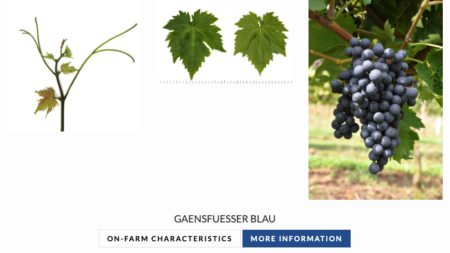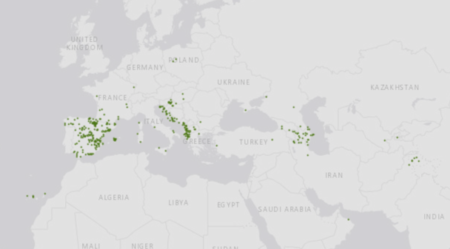- Modelling crop diversification and association effects in agricultural systems. Intercrop, people!
- Cooking up Diverse Diets: Advancing Biodiversity in Food and Agriculture through Collaborations with Chefs. Yeah, yeah, chefs are great. Now show me the data.
- Multivariate analysis and selection criteria for identification of African rice (Oryza glaberrima) for genetic improvement of indica rice cultivars. Go for high number of productive tillers and early maturity.
- Strategies for Sustainable Use of Indigenous Cattle Genetic Resources in Southern Africa. Not just genetic improvement: also need better nutrition, healthcare, marketing, and infrastructure; integration and empowerment of women and youth; and capacity building, regulatory, and policy frameworks. Not unlike crops, really.
- Population structure of Miscanthus sacchariflorus reveals two major polyploidization events, tetraploid-mediated unidirectional introgression from diploid M. sinensis, and diversity centred around the Yellow Sea. The centre of origin in under water.
- Remote sensing for agricultural applications: A meta-review. Yeah, yeah. Call me when you have a way of distinguishing landraces from modern varieties.
- Genetic Diversity of Sweet Potato (Ipomoea batatas L. Lam) Germplasms Collected Worldwide Using Chloroplast SSR Markers. 500 is not enough.
- Seed germination and storage studies in seed-fertile Musa indandamanensis and its conservation. Intermediate.
- Cultivated olive diversification at local and regional scales: evidence from the genetic characterization of French genetic resources. Areas with unexpected frosts have been, paradoxically, good for olive diversity.
- Genetic diversity of Nile tilapia (Oreochromis niloticus) throughout West Africa. Corresponds to river basins. Well there’s a shocker.
- Protecting half of the planet could directly affect over one billion people. Add lowest-footprint pixels to PAs until you get to 50% coverage of each ecoregion, then count how many people live in PAs, for good or ill.
- Food Access Deficiencies in Sub-saharan Africa: Prevalence and Implications for Agricultural Interventions. Livestock helps, higher income not necessarily.
- Can a speed breeding approach accelerate genetic gain in pigeonpea? I’m going to guess yes.
- Hypoallergen Peanut Lines Identified Through Large-Scale Phenotyping of Global Diversity Panel: Providing Hope Toward Addressing One of the Major Global Food Safety Concerns. Lots of diversity to play with.
- Revolturas: resisting multinational seed corporations and legal seed regimes through seed-saving practices and activism in Colombia. Everybody’s at it.
Nibbles: Sacred forests, Morning glory, Organic cereals, Sorghum diversity, Phoenix studentship
- The church forests of Ethiopia.
- Monumental monographic study of Ipomoea.
- New project on breeding cereals for organic farming in Europe.
- Sorghum genetic resources in the USA.
- Fun studentship on date palm diversity.
Brainfood: Accessibility data smorgasbord, Microclimate megadataset, Breeding strategies, Aeroponic cassava, Jatropha conservation, Wheat diversity, Botanic gardens, Polyploid duo, Rhizosphere symbiosis, Selfing niches, Pepper priorities, Eggplant core, Ipomoea evolution, Kenyan supermarkets
- A suite of global accessibility indicators. How long it takes to get from anywhere in the world to settlements of different size. Or took, in 2015.
- A method for computing hourly, historical, terrain‐corrected microclimate anywhere on Earth. Why you might want to move in the first place.
- Genetic strategies for improving crop yields. “Valuable genetic diversity for increasing crop resilience resides in cultivated landraces, heirloom varieties and the wild relatives of crops.”
- A low-cost aeroponic phenotyping system for storage root development: unravelling the below-ground secrets of cassava (Manihot esculenta). But sometimes you have to work hard to get at it: case in point.
- High SNP diversity in the non-toxic indigenous Jatropha curcas germplasm widens the potential of this upcoming major biofuel crop species. And here’s another.
- Genome-wide variation patterns between landraces and cultivars uncover divergent selection during modern wheat breeding. In China and Pakistan anyway.
- Plant populations of three threatened species experience rapid evolution under ex situ cultivation. So don’t cultivate, store seeds instead. Or as well.
- Genes derived from ancient polyploidy have higher genetic diversity and are associated with domestication in Brassica rapa. Polyploidy pre-adapts plants for domestication.
- Genome duplication effects on functional traits and fitness are genetic context and species dependent: studies of synthetic polyploid Fragaria. Case in point.
- A mutualistic interaction between Streptomyces bacteria, strawberry plants and pollinating bees. The rhizosphere protects.
- Do selfing species have greater niche breadth? Support from ecological niche modeling. Yes indeed.
- Modelled distributions and conservation status of the wild relatives of chile peppers (Capsicum L.). 50% are high priority for conservation. No word on their mating systems.
- Construction of a core collection of eggplant (Solanum melongena L.) based on genome-wide SNP and SSR genotypes. From 893 to 100, in 4 geographical clusters.
- A taxonomic monograph of Ipomoea integrated across phylogenetic scales. A whole bunch of new species, and evidence that some 60 species independently developed storage roots before humans were even around. Yes, even sweetpotato.
- Supermarket food purchases and child nutrition in Kenya. Not a bad thing.
Yes, we have plenty of banana information, take 2
A new version of the Musa Germplasm Information System (MGIS) is out. There’s more data, tools for better curation, a way to search for accessions cited in the literature, and re-organized menus. Do check it out. MGIS data eventually makes its way to Genesys.
And since I’m here, it’s worth noting that the banana is uniquely well-endowed with information resources. In addition to MGIS, there’s a whole slew of other databases and assorted information products, thanks to the wonder that is ProMusa.
ProMusa is a network of people promoting scientific discussions on bananas.
In alliance with the International Society for Horticultural Science (ISHS), the network organizes scientific symposia (reported in proceedings) to help its members stay up-to-date on the latest research developments and encourage collaborations within and between disciplines.
When not meeting face-to-face, ProMusa members stay in touch using the network’s mailing list.
This website is the network’s online platform, which offers news, knowledge and information on bananas.
 The centrepiece is Musapedia, “an online, collaboratively built compendium of knowledge on bananas.” But there are also databases of scientific literature, images and contacts. And an excellent news area — InfoMus@.
The centrepiece is Musapedia, “an online, collaboratively built compendium of knowledge on bananas.” But there are also databases of scientific literature, images and contacts. And an excellent news area — InfoMus@.
You can follow — and interact with — ProMusa on Facebook and Twitter. I can’t think of a crop that has anything similarly comprehensive. It really should be your first port of call for anything to do with bananas.
Gabe Sachter-Smith laid out in a spiral a sample of the more than 100 types of bananas documented during the collecting mission to West New Britain, PNG. They include the ever mysterious Fe'i banana, photographed next to its possible ancestor, Musa maclayi. pic.twitter.com/HahIXm1P4K
— ProMusa (@promusa_banana) October 11, 2019
BTW, the title of this post refers to a previous foray into banana information resources.
Old vines in a new catalogue
Who doesn’t love old trees? I, for one, could read about them for days. And, alas, have occasionally done so. Especially if they are cultivated species. The internet is full of old, attractively gnarled olive trees, for example. Old grapevines, not so much. There was recently that piece in The Economist about recreating Leonardo’s vineyard, but that’s not quite the same thing.
So it was a pleasant surprise to come across the Old Vines Register, curated by wine expert Jancis Robinson. Turns out there are some 400-year-old vines out there. Which I’d really like to see some day.
Anyway, since I’m talking grapes, I might as well highlight the work of the Vitis Working Group of the European Cooperative Programme for Plant Genetic Resources (ECPGR). Note in particular their “On-farm inventory of minor grape varieties in the European Vitis Database.” There must be some pretty old vines among those.

As for genebanks, there are 16,000 accessions of cultivated Vitis out there (plus 2,400 wild relatives), according to Genesys, though only about 1,900 are geo-referenced (see map below). Genesys, remember, brings data from ECPGR’s European genebank database, Eurisco, together with that from genebanks in other parts of the world. There is also a separate European Vitis Database, though I’m not sure of the exact overlap with Eurisco.

What of the future? Well, we’re probably going to need all that diversity given what climate change is already doing to the crop. A recent Twitter thread by Dr Sarah Taber analyzed the depiction of vineyards in an episode of Star Trek: The Next Generation set in the year 2367. We’ll just have to see if her decidedly critical view of twenty-fourth century management practices is borne out in the forthcoming series, which does seem to feature, at least according to the trailer, somewhat better kept, though not particularly old-looking, vines. No word yet on what varieties the Picards grew, and will grow.
https://www.youtube.com/watch?v=Ishyf14_yx0